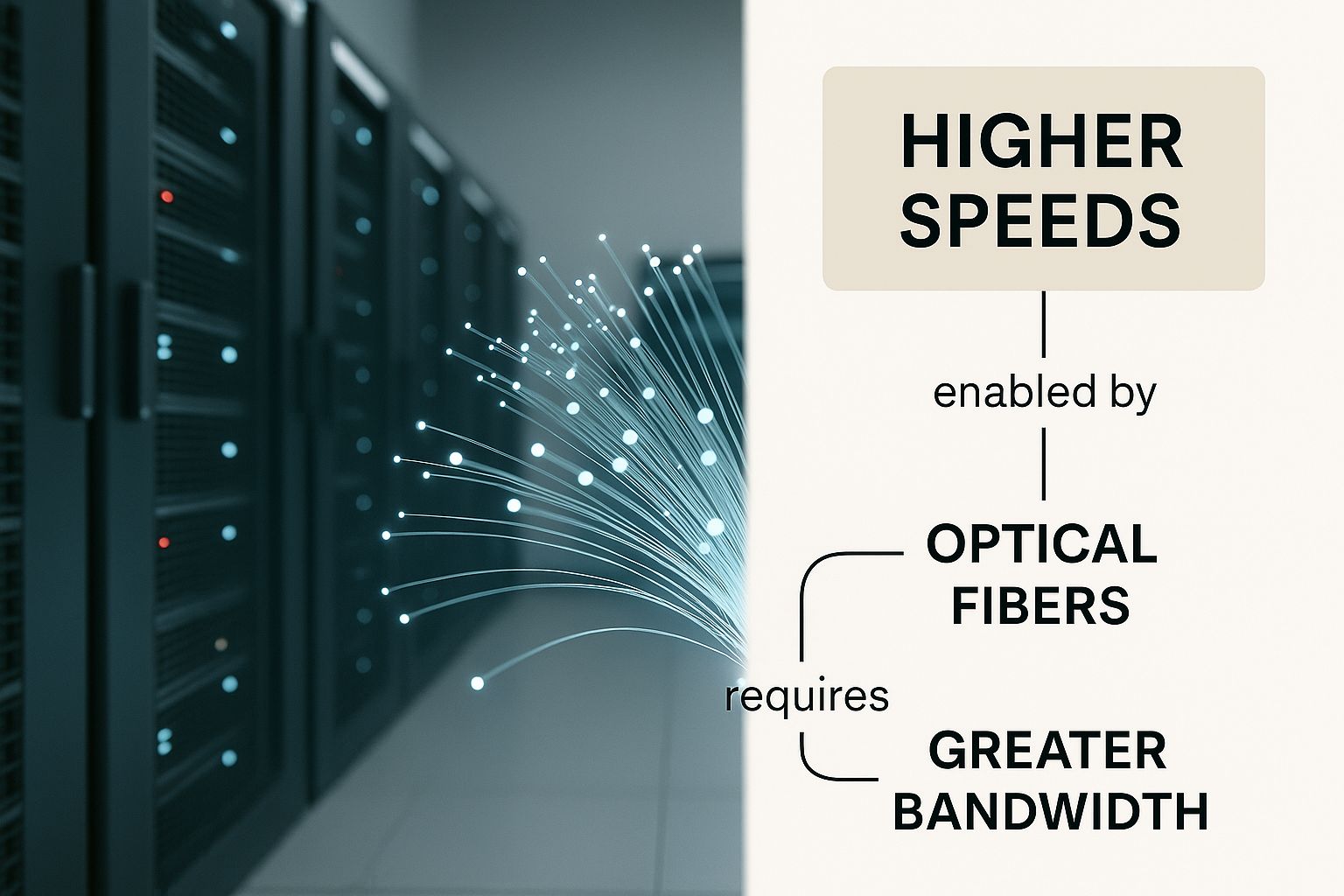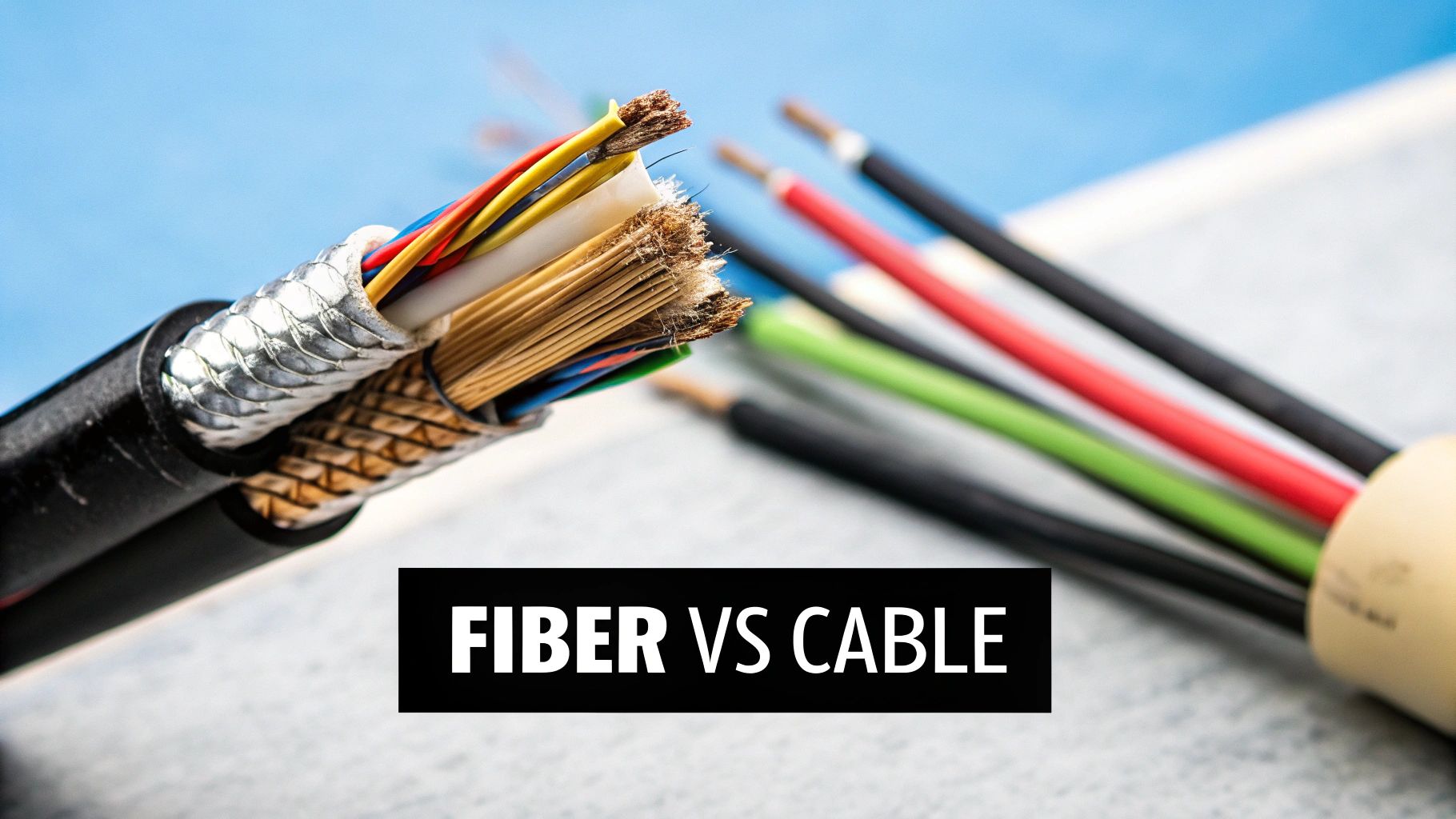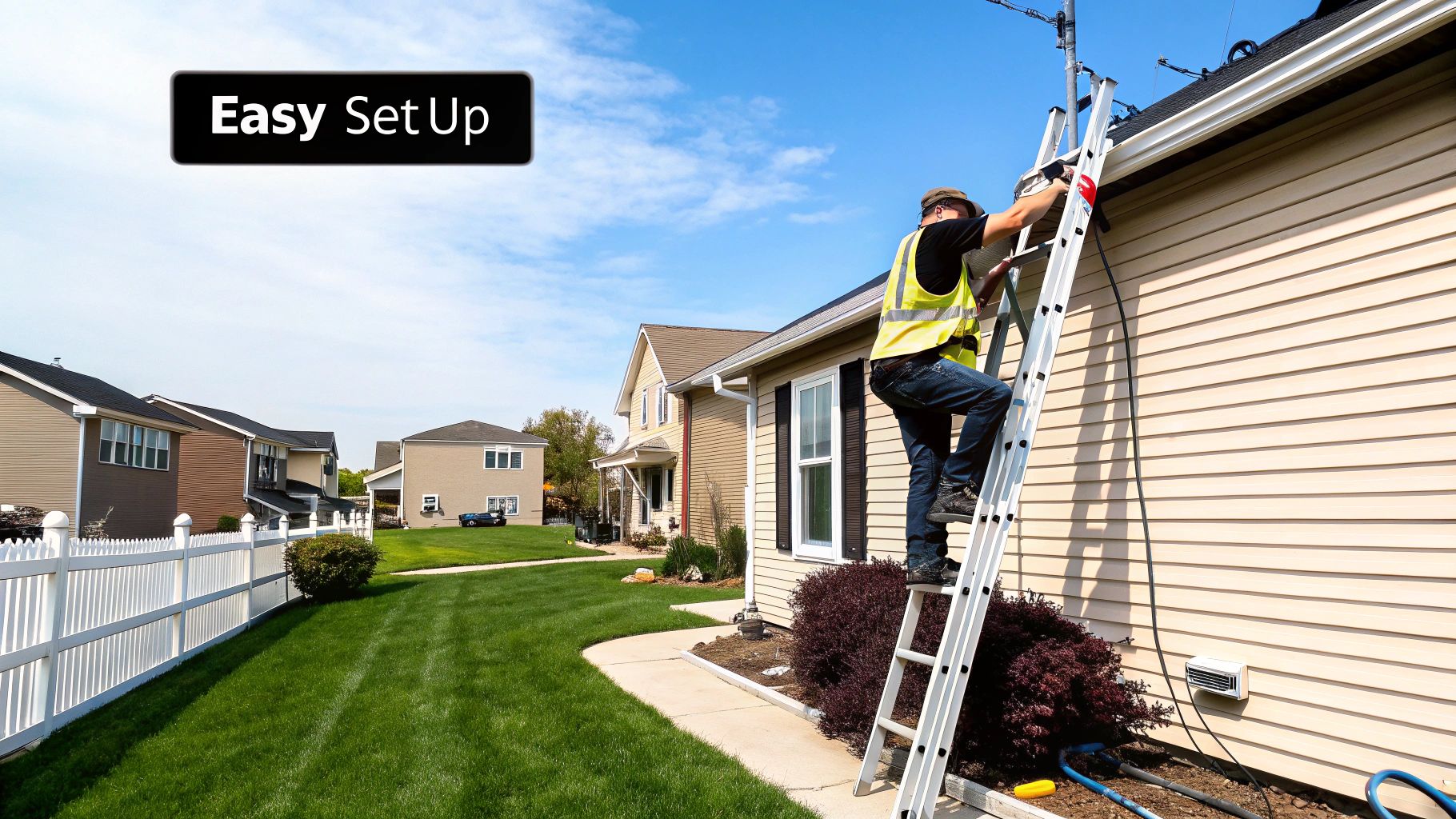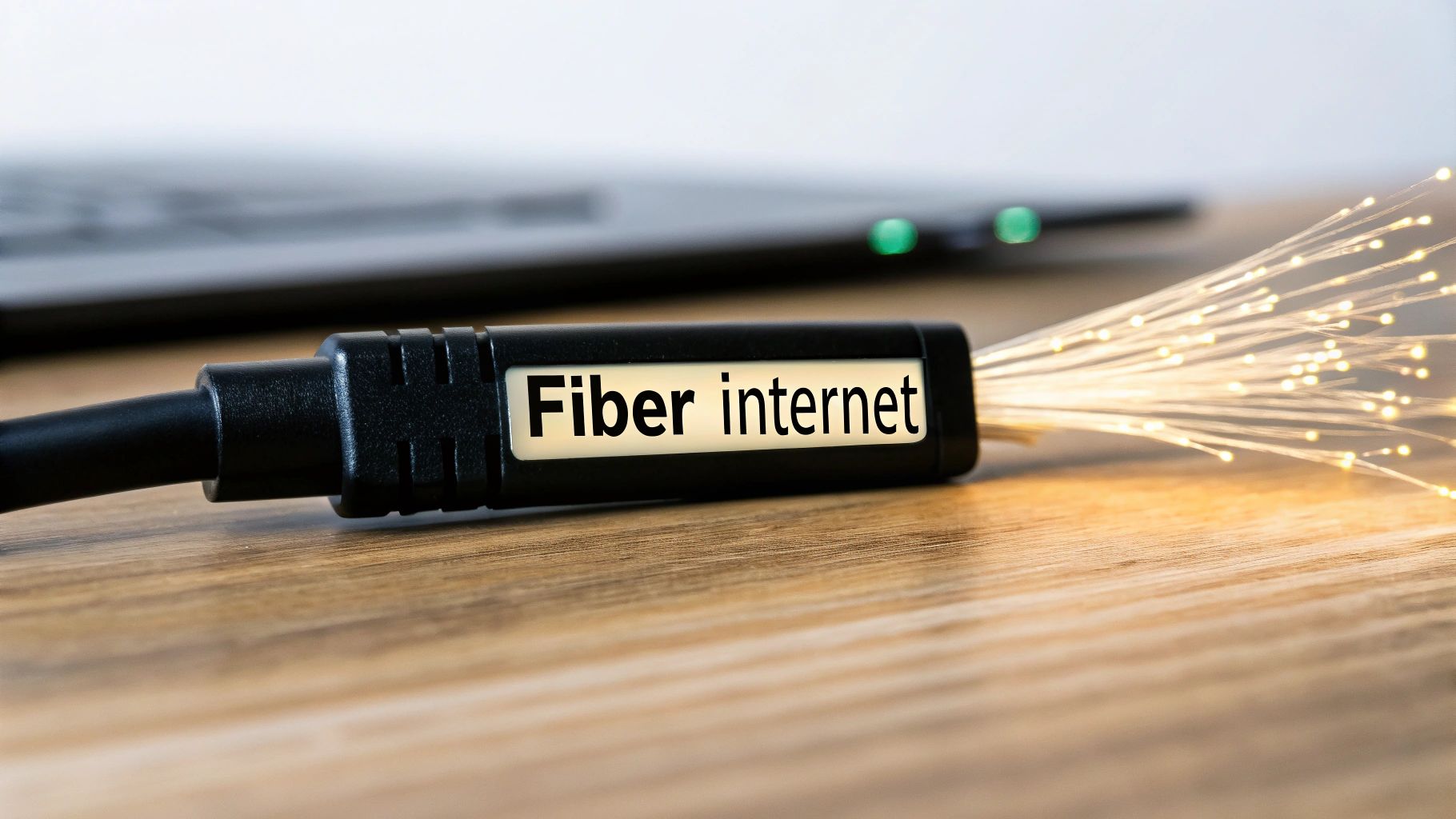At its core, a fiber internet connection works by sending data as pulses of light through impossibly thin strands of glass. It’s the difference between a dedicated, multi-lane superhighway for your data and the stop-and-go traffic of a congested city street, which is what you get with older cable and DSL technologies.
This fundamental difference is what gives fiber its incredible speed and rock-solid reliability.
What Is Fiber Internet, Really?
In the simplest terms, fiber internet is a way to get online using fiber-optic cables. Instead of pushing electrical signals down old copper wires like traditional internet services, fiber uses light. Light travels faster and is far more resilient to outside interference.
The result? A remarkably stable, high-performance connection that can handle just about anything you throw at it.
This isn't just about getting faster downloads. It completely changes the online experience. For a business, that means cloud applications run without a hitch and video calls are always crystal clear. For a multi-family property or senior living community, it means every single resident can stream, work, and connect all at once without anyone’s connection grinding to a halt. You feel the difference immediately.
How Fiber Stacks Up
To really get a feel for what makes fiber different, it helps to compare it to the connections most of us have been using for years. This isn't just a small step up; it's a completely different way of moving information. The medium itself—glass versus copper—is what changes the game.
One of fiber's biggest advantages is its total immunity to electromagnetic interference. Copper cables can be disrupted by nearby power lines or electrical noise, but fiber’s light-based signal is completely unaffected, leading to a much cleaner and more dependable connection.
The installation process is also unique, requiring specialized equipment to handle those delicate glass fibers. If you're thinking about making the switch, it’s worth knowing what’s involved. You can get a detailed look at the process in our guide on how to install fiber optic cable.
Fiber Internet vs Traditional Connections at a Glance
Sometimes a simple side-by-side comparison is the best way to see the differences. This table breaks down where each technology really stands out—and where it falls behind.
| Attribute | Fiber Internet | Cable Internet | DSL Internet |
|---|---|---|---|
| Technology | Light over glass strands | Electrical signals over coaxial cable | Electrical signals over phone lines |
| Max Speed | Extremely high (1 Gbps and beyond) | High (up to 1 Gbps download) | Moderate (up to 100 Mbps) |
| Upload Speed | Symmetrical (same as download) | Asymmetrical (much slower than download) | Asymmetrical (much slower than download) |
| Reliability | Excellent, weather-proof | Good, but can slow with neighborhood use | Fair, sensitive to distance from hub |
As you can see, fiber leads the pack in every key performance metric, from raw speed to the consistency of the connection.
How Light Delivers Your Internet
To really get your head around fiber internet, imagine you're trying to send a message down a long, perfectly mirrored tunnel. Instead of shouting—where your voice would echo and fade—you use a flashlight to send Morse code. The light beams bounce perfectly down the tunnel, protected from any outside interference, traveling for miles at incredible speed without losing a bit of their clarity.
That's pretty much how fiber optics work. We're not pushing electrical signals through old copper wires anymore. Instead, our data is converted into tiny pulses of light. These light pulses then zip through hair-thin strands of pure glass, which act just like that mirrored tunnel.
The Journey of Data as Light
It all starts at a network's central hub, sometimes called a central office. Here, a key piece of gear called an Optical Line Terminal (OLT) does the heavy lifting. The OLT is the starting gate, converting the standard electrical signals of the internet into powerful pulses of light ready for their journey.
Think of the OLT as the person holding the super-powered flashlight at the beginning of our tunnel. It takes your data—the message—and translates it into a precise series of on-and-off flashes. These flashes, representing the ones and zeros of binary code, are then shot into the fiber optic cable, beginning their near-instantaneous trip.
This is the secret to fiber's amazing speed: it uses light, the fastest thing we know, as its messenger.

The glowing cables you see in server rooms are a great visual reminder of the advanced tech that makes these speeds possible.
From Light Pulses Back to Data
That pulse of light doesn't just travel through an empty tube. It races through a network of cables that can stretch for miles, either underground or on poles. Inside each cable, the light is kept perfectly contained by an outer layer called cladding.
The cladding has a different optical property than the glass core, which forces the light to constantly bounce inward. This phenomenon, known as total internal reflection, acts like a perfect mirror, ensuring the light signal never escapes or weakens over distance.
Finally, after its journey, the light arrives at your property and connects to a device called an Optical Network Terminal (ONT). This small box is the final stop for the fiber line and plays a crucial role.
The ONT is essentially a translator. Its job is to instantly convert the incoming pulses of light back into the electrical signals that your devices—like your router, computers, and Wi-Fi access points—can actually understand. It’s the person at the other end of the tunnel, catching every single flash and reassembling the original message perfectly.
This seamless conversion from light back to usable data is what closes the loop, delivering an internet connection with speed and reliability that older technologies just can't touch. Because the signal travels as light through a protected glass core, it’s immune to the electrical interference and signal degradation that constantly plague traditional copper-based systems.
The Real-World Benefits of a Fiber Connection
It’s one thing to understand the science behind fiber internet, but it's another to see how it performs in the real world. That’s where this technology truly makes its mark. The advantages go way beyond just loading websites faster; they fundamentally change how businesses operate and how people connect in their daily lives.

The practical benefits of fiber really come down to three core strengths: incredible speed, rock-solid reliability, and enormous bandwidth. These aren’t just abstract terms—they are the direct solutions to everyday frustrations like buffering videos, dropped video calls, and glacial file uploads that plague older internet connections.
Experience Blazing-Fast Symmetrical Speeds
One of the biggest game-changers with fiber is its ability to deliver symmetrical speeds. In simple terms, this means your upload speed is just as fast as your download speed. With traditional cable or DSL, your uploads are usually just a tiny fraction of your download rate, creating a frustrating bottleneck for so much of what we do online today.
Why is this such a big deal?
- Flawless Video Conferencing: Your video feed stays crisp and clear without freezing or lagging, making remote work and virtual meetings genuinely productive.
- Instant Cloud Backups: Sending huge files to cloud services like Dropbox or Google Drive can take seconds, not minutes or even hours.
- Seamless Content Creation: For anyone uploading high-resolution videos, streaming live, or sharing massive design files, symmetrical speeds are absolutely essential.
This balance between uploading and downloading eliminates the digital waiting game. It empowers everyone to both consume and create online content without a hitch, a critical capability for any modern property or business. You can dive deeper into this topic in our article covering the benefits of fiber optic cable.
Unshakeable Reliability and Consistency
Ever notice your internet slowing to a crawl during a storm? Or how it gets sluggish at 5 PM when everyone in the neighborhood logs on? Those are common headaches with copper-based connections like cable and DSL, which are easily affected by electrical interference and network congestion.
Fiber is a different breed. Because the signal travels as light through glass strands, it's completely immune to electromagnetic interference. Nearby power lines, bad weather, or electrical "noise" from other equipment simply don't affect it, which means you get a remarkably stable and consistent connection.
For a business, this translates to fewer random slowdowns and less unexpected downtime—a must when you rely on a constant connection for everything from point-of-sale systems to security cameras. Residents in a multi-family property get an experience that just works, day in and day out. This stability is a massive leap forward, making the internet feel dependable instead of unpredictable.
Fiber vs. Cable vs. DSL: What’s the Real Difference?
To really get why fiber internet is such a big deal, it helps to see it next to the older tech it’s pushing aside. For years, cable and DSL were the go-to options, but they were built on foundations meant for something else entirely—cable for TV and DSL for phone calls. Fiber was designed from day one with a single mission: moving massive amounts of data at the speed of light.
That fundamental design difference creates a clear divide in performance. When you dig into the details, it’s easy to see why fiber is quickly becoming the only serious choice for businesses and properties where top-tier connectivity is non-negotiable.
It All Comes Down to the Wires
The core of the comparison lies in what each technology uses to send information. Think of it as the difference between a modern superhighway and a winding country road.
-
DSL (Digital Subscriber Line): This one uses the old copper telephone lines already in the building. Its biggest drawback is distance—the further you are from the provider’s main hub, the slower and more unreliable your connection gets. It’s the weakest link in today’s internet landscape.
-
Cable Internet: This technology runs on the same coaxial cables that bring you cable TV. It’s a huge step up from DSL, but it has an Achilles' heel: it's a shared network. That means your internet speed can take a nosedive during peak hours when everyone else in the area is online, too.
-
Fiber-Optic Internet: Instead of electricity through copper, fiber uses pulses of light shot through impossibly thin strands of pure glass. This completely bypasses the limitations of metal wiring. It isn't a shared "party line" like cable and is totally immune to the electrical interference and signal decay that plague both DSL and cable.
This isn't just a minor upgrade; it's a global shift. In 2023, fiber internet already made up 42.5% of all fixed broadband connections worldwide, leaving older copper cable (29%) and DSL (20.3%) in the dust. While the U.S. grew its fiber footprint by 14.5% in 2023, some countries are moving even faster—Greece, for example, saw its fiber access jump by an incredible 78.8% in the same year. You can dive deeper into these trends with Tachus's global fiber adoption analysis.
To help illustrate these differences, here's a side-by-side comparison of the three main connection types.
Detailed Breakdown of Internet Connection Types
| Feature | Fiber Optic Internet | Cable Internet | DSL Internet |
|---|---|---|---|
| Technology | Light pulses through glass strands | Electrical signals over coaxial cable | Electrical signals over copper phone lines |
| Max Download Speed | Up to 10 Gbps or higher | Up to 1 Gbps | Up to 100 Mbps |
| Upload Speed | Symmetrical (same as download) | Asymmetrical (much slower than download) | Asymmetrical (severely limited) |
| Latency (Ping) | Extremely low (1-5 ms) | Low to moderate (10-30 ms) | Moderate to high (30-100+ ms) |
| Reliability | Highest; immune to EMI and distance decay | Good, but can be affected by network congestion | Lowest; highly susceptible to distance and line quality |
| Best For | Gaming, 4K streaming, cloud apps, large file transfers | General browsing, HD streaming, most online activities | Basic browsing, email, light use |
As you can see, fiber leads the pack in every critical performance metric, from raw speed to the stability of the connection itself.
Performance Under Pressure
The real-world impact of these technical specs shows up when you really push the connection. Think about a multi-family property with dozens of tenants streaming 4K video, a competitive gamer who needs zero lag, or a business relying on cloud software to run its operations. For them, a simple "download speed" number doesn't tell the whole story.
Latency, often called ping, is the ultimate tiebreaker. It’s the tiny delay it takes for a signal to travel from your computer to a server and back again. Fiber’s light-speed transmission crushes this delay, resulting in ultra-low latency that gives gamers an edge and makes video calls feel seamless and immediate.
Cable and DSL, with their electrical signals and congested networks, just can't keep up here. That delay is far more noticeable, causing that frustrating lag in online games or that awkward moment when people talk over each other on a video conference. Fiber’s combination of low latency and symmetrical speeds delivers a consistently smooth and responsive experience that older connections can't touch, especially when the network is busy.
Why Isn't Fiber Everywhere Yet?
With all the talk about its blazing speeds and reliability, you might be wondering: if fiber is so great, why can’t I get it at my property? The short answer is that building a brand-new infrastructure from the ground up is an incredibly expensive and complex undertaking.

Think about how cable and DSL internet came to be. They were clever workarounds, piggybacking on the coaxial TV and copper phone lines that were already wired into nearly every building. Fiber doesn't have that luxury. It requires a completely new network of delicate glass strands to be physically laid, often involving digging up streets, navigating a maze of local permits, and trenching lines to each individual property.
It's a massive construction project, and the hurdles multiply quickly in dense cities or spread-out rural areas.
The "Last Mile" Problem
The biggest bottleneck in any fiber rollout is what we in the industry call the "last mile." This is the final—and most difficult—stretch of cable that connects the main fiber line running down the street to a specific building. It’s where the costs and complexity really skyrocket.
Imagine a new interstate highway being built. That’s like the main fiber trunk. But now, picture having to build a private, paved driveway from that highway to every single house in every town it passes. That's the last mile. Each connection requires its own crew, its own permits, and its own physical labor, making it the most expensive part of the whole process.
The sheer cost of deploying fiber is staggering. In a typical city, laying fiber optic cable underground can run as high as 4,000 per mile. That price tag includes excavation, navigating the bureaucracy of permits, and then restoring everything back to its original condition. These massive upfront costs are the primary reason providers are slow to expand into less populated areas.
This huge investment explains why internet service providers (ISPs) tend to focus on high-density areas first, where they can connect more customers and get a faster return on their investment. For businesses looking for alternatives, newer models like Network as a Service (NaaS) are emerging to provide access to high-end infrastructure without the crippling upfront expense. You can learn more in our guide on what is Network as a Service.
How 5G is Actually Helping
It might sound strange, but the rollout of 5G wireless technology is actually accelerating the spread of fiber. While they seem like competing technologies, 5G absolutely depends on a rock-solid fiber foundation to work.
Every single 5G cell tower requires a massive-capacity connection to the internet's backbone to handle all that wireless traffic. The only technology that can deliver that kind of bandwidth is fiber. So, as mobile carriers blanket the country with 5G towers, they are also laying thousands of miles of new fiber optic cable. This new fiber can then be tapped into by nearby homes and businesses, helping to close the availability gap for everyone.
Is a Fiber Connection Actually Worth It for You?
We’ve covered the mechanics of fiber and the serious advantages it brings to the table. But the big question remains: is it the right move for your property? The answer isn't found in a spec sheet; it's about how your tenants, employees, and you actually use the internet every single day.
Forget the hype for a moment and take a quick, honest look at your current situation. Think about the sheer number of devices fighting for bandwidth on your network. A small office or even a single apartment can easily have dozens of gadgets online at once—laptops, phones, smart TVs, security cameras, you name it. If you’re already noticing frustrating slowdowns when everything is running, fiber's massive capacity is the clear answer.
Create a Quick Gut-Check List
To really get to the bottom of it, ask yourself a few pointed questions about your day-to-day internet life. The answers will tell you whether fiber is a critical upgrade or just a nice-to-have.
- How much do you push data out? If your world revolves around video calls, uploading huge files, or live streaming, then fiber's symmetrical speeds are a total game-changer. For these activities, a fiber connection is practically a necessity.
- Do you have any "power users"? Think about the competitive gamer who needs ultra-low latency, the remote worker whose job depends on a rock-solid connection, or the family trying to stream 4K movies on three different screens. These are the exact scenarios that make older connections buckle.
- Is consistency non-negotiable? For any business, reliability is everything. If internet dropouts or sluggish performance during peak hours are costing you money and productivity, fiber’s resilience to interference provides a stable backbone you can build on.
Looking at these real-world needs helps you build a case for your specific situation. It’s not about having the fastest speed just for bragging rights; it's about matching the right technology to your actual demands for a smooth, frustration-free online experience.
Answering these questions honestly cuts through the technical jargon and gets right to the heart of what fiber truly delivers. It makes it clear whether the investment will bring a real, tangible improvement to your daily operations and digital life, turning a tough decision into a confident one.
Ready to see how a fiber internet connection can boost your property's performance and value? Clouddle Inc. specializes in designing and installing high-speed, reliable network solutions for businesses in hospitality, multi-family, and commercial sectors. Learn more about our managed technology services at Clouddle Inc. and discover what seamless connectivity really feels like.


